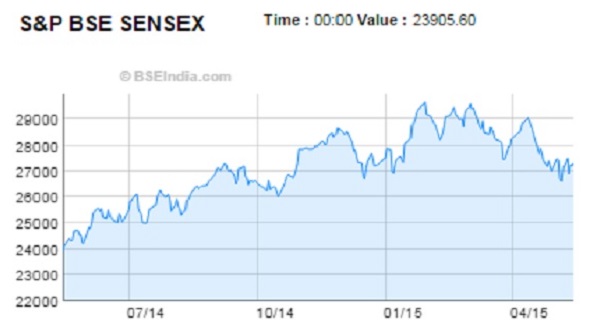 The S&P BSE Sensex over the first year of the Modi-led UPA government. (Source: BSE India)
The S&P BSE Sensex over the first year of the Modi-led UPA government. (Source: BSE India)
If there is one thing about stock markets you can be sure of, it’s their unpredictability.
From 27,500 on Monday, the S&P BSE Sensex crashed to 26,877 by end of day Tuesday. On Wednesday it gained some ground yet it was about 3,000 points down from its high of nearly 30,000, just two months back. While it recovered some ground closing the week at 27,324, it was small comfort for investors who have been holding on tight as the topsy-turvy ride of the Indian equity markets continued this week.
Mounting Woes
The euphoria of early March is clearly over. Each day (and trading session) seems to bring with it some adversity or the other. It could be corporate concern over the Modi government’s reform agenda slowing down, the Greek debt repayment crisis, plunging global bond prices or sudden demands being made by the Indian tax authorities from foreign investors. These sudden flashes spook an already jittery market but coming as they are against a backdrop of dismal macroeconomic data, the fallout is more acute.
The Index of Industrial Production (IIP) for March announced this week was 2.1% compared with 4.9% in February, a five month low. In a sign that companies are not borrowing money and investing, non-food credit offtake slowed to 10.19 percent at Rs 65,24,257 crore for the fortnight ended 6 March, according to the Reserve Bank of India.
Consumer demand is slowing down everywhere, including rural India. India Inc. expects that the next set of corporate earnings will be average at best.
The Indian Met department says that monsoons will be deficient and the El Nino phenomenon may damage crops like wheat, rice, soya beans, coffee and sugarcane across Asia.
Sure the consumer price index (CPI) has eased to 4.87% due to which food prices might be kept in check but then the RBI is using that as an excuse to not cut interest rates.
The Uncertainty Is Set To Continue
And without cutting interest rates how will we spur investment and drive consumer demand, both of which are urgently needed to keep the economy from stalling? Especially given that the INR has been appreciating steadily, seriously hampering the export-competitiveness of Indian firms in the global market. According to the Centre for Monitoring Indian Economy (CMIE), Indian exports tanked by 15% to touch a 51-month low in February this year.
Is it possible that the year-long stock market party that kicked off with the victory of the business-friendly Modi-led UPA government has come to an end? - Most likely.
And now after the party the hangover is far from pleasant. Suddenly hard questions are being asked, hard numbers pored over. Where are all the so-called reforms? Two big-tickets reforms - GST and the Land Bill - are still stalled. Though Finance Minister Jaitley says the deadline of April 2016 will be met, the GST will now sit before a select committee of the Rajya Sabha and will be cleared in the monsoon session at best. On the Land Bill, the Congress has been giving the government a hard time and a joint parliamentary committee will now study the bill, delaying it further.
These are uncertain times to be sure. Volatility, measured by the National Stock Exchange’s NSE VIX Index and used by option traders is now close to 20. This is quite high and it means that sudden surges by the markets – either up or down – are most likely. It also means that no one is sure of which way the markets will go and money managers are taking it a day-at-a-time.
Historically, high volatility is always accompanied by choppy markets. This is because savvy market makers use the spurts to book profits and while others may buy into the dips, seeing it as a long term opportunity to get it and ride what undoubtedly still continues to be a bull market.
So what should investors do? For the time being nothing. If you are not already invested in equity this is definitely not the time to get in fresh. And if you are already holding an equity exposure, then there is no rush to cash out.
The Way Ahead
Fluctuations or ‘corrections’ are a regular feature of all bull markets. According to a report in The Economic Times, historically when Indian equity markets correct it is by anything between 10% - 30% and when they recover it could be by as much as 65%.
Market experts say that that the quarterly re-jigging of the MSCI Index, effective the end of May will help. MSCI is a popular and influential emerging market index used by money managers across the world and if India’s weightage increases (the street expectation is by 50 basis points) then it should see fresh money coming into Indian equity.
While the Modi government may not have delivered yet on the high expectations investors had, the India story is still intact. Current account deficit, thanks to low global oil prices is under control. Inflation has been checked. India’s demographic dividend is intact, as is its English-speaking workforce. A UN report says the Indian economy is expected to grow at 8.1% in the current financial year.
The acche din may have been delayed, but with a bit of luck (and a good monsoon) the bull run on Dalal Street may renew.